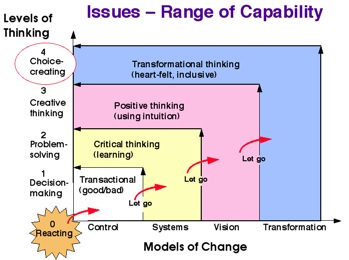HOW DYNAMIC FACILITATION WORKS
The primary role of the dynamic facilitator is to support the creative process of people by creating a reflective environment where each person and the group self-organize. The group enters the “creative flow” of choice-creating. Choice-creating is similar to dialogue in that people explore topics open-mindedly and open-heartedly, yet unlike dialogue it helps groups address practical problems and reach joint conclusions and actions. Choice-creating is similar to deliberation in that the result can be a thorough examination of a practical issue, including pros and cons of various solutions; yet unlike deliberation, it is creative and avoids judgment.
The dynamic facilitator helps people to determine an issue they care about. Then he or she helps them to be authentic, speaking their minds and hearts. The dynamic facilitator assures that each comment is an asset to the conversation, using four lists:
- Solutions
- Concerns
- Data
- Problem Statements

Dynamic Facilitation provides a way to:
- work with people as they are, without pre-meeting trainings or complex guidelines;
- for people to work on “big” problems and “impossible-to-solve” issues;
- release people from the usual linear, step-by-step process or pre-established agenda to work with what is alive for people in the moment;
- achieve unanimous results without negotiating agreements or compromises;
- generate motivation and action since people “arrived at the solution themselves”.
How is Dynamic Facilitation different from other forms of facilitation?
The dynamic facilitator works more completely with self-organizing change than a traditional facilitator. The traditional facilitator uses methods of control to manage how people think, talk, and decide. They aim toward managing problems by breaking big issues into smaller ones, following an agenda or logical steps, and tracking progress toward predetermined goals. This approach works well for smaller, unemotional issues, but is less effective for the big messy ones. It aims to minimize what might go wrong.
The dynamic facilitator elicits a self-organizing dynamic both in what people talk about and how they talk. He or she follows group energy as being more important than any preset agenda, where progress happens in “shifts” of insight, feeling, and awareness. This process builds trust and new capabilities via a more heartfelt, creative thinking process known as “Choice-creating”. This approach maximizes what might go right instead of minimizing what might go wrong.
See a chart comparing Dynamic Facilitation with Traditional Facilitation
